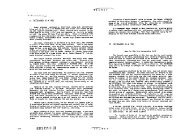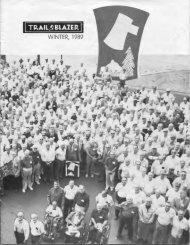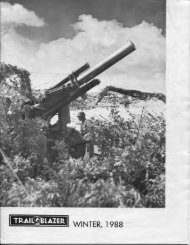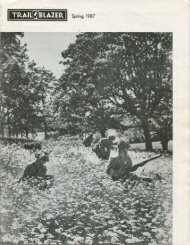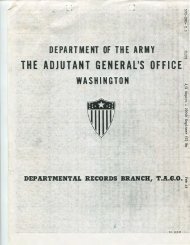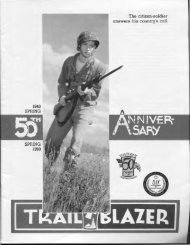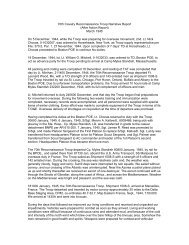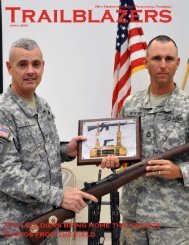Download - 70th Infantry Division Association
Download - 70th Infantry Division Association
Download - 70th Infantry Division Association
You also want an ePaper? Increase the reach of your titles
YUMPU automatically turns print PDFs into web optimized ePapers that Google loves.
At 1146 Company A took its first objective and Company C took temporary control.of Obermuhlthal, while<br />
the other units continued to advance without resistance. However, Company A was ordered to hold up its<br />
progress at this point. because of the slower advance of the 2d Battalion due to terrain, and the<br />
impracticability of by-passing Obermuhlthal.<br />
Company C was hit by a counterattack at 1410 and at the same time Company B was subjected to heavy<br />
artillery fire. A request was again sent to the Commanding Ceneral, 45th <strong>Division</strong>, to have the 2d<br />
Battalion, 275th <strong>Infantry</strong>, aid the 1st Battalion, 276th <strong>Infantry</strong>, by taking over Obermuhlthal.<br />
The 1st Battalion had the situation under control at 1530 but at 1555 a small arms and artillery attack was<br />
made on its CP. This was repulsed. The 2d Battalion was under machine gun fire and artillery fire was<br />
landing on the 3d Battalion. At 1700 the 1st Battalion reported Obermuhlthal cleared. S-3 of - the 275th<br />
<strong>Infantry</strong> had refused permission to register artillery fire north and northwest of Obermuhlthal because of<br />
danger to his troops. As of 1800 plans were being made to defend the ground held. There was active<br />
patrolling by our units and the enemy during the night.<br />
S-3's conclusions of the day's action was that the 276th <strong>Infantry</strong> had accomplished the initial phases of its<br />
mission, but that better results would have been obtained if it had not been necessary to turn aside from<br />
our mission on the right flank.<br />
On January 9, 1945, we engaged in battle north of Offwiller, France at about 1700. We had one enlisted<br />
man missing in action, two enlisted men killed in action and four enlisted men wounded in action. Those<br />
killed in action were brought back and laid along side the road so everyone could look at them. Those<br />
seriously wounded in action were immediately withdrawn to the regimental hospital set up in the rear<br />
some place. The medics put them on stretchers and got them to an ambulance.<br />
At dawn of 10 January 1945 the attack was resumed with the 2d Battalion on the left, 1st Battalion on the<br />
right and 3d Battalion in reserve position on its original objective. The regiment continued to push forward<br />
throughout the day, after front lines were straightened for easier contact between units.<br />
On this day S-2 reported that enemy units in contact were 2d Battalion, 477th Regiment, 257th <strong>Division</strong>,<br />
and 1st and 2d Battalions, 952d Regiment, 361st <strong>Division</strong>. No reserves had been located. Enemy<br />
strength was reported as greatly reduced and battalions operating with 60 to 200 men, some with only<br />
one officer. Morale of all Volkssturm Guards was found to be exceedingly low, but SS units had the same<br />
high morale and fighting spirit as previously. More enemy field artillery was being encountered.<br />
The S-1 report showed that replacements needed by the 276th <strong>Infantry</strong> now stood nine officers and 283<br />
enlisted men. For the period 7, 8, 9 and 10 January 1945 there had been 91 casualties evacuated. There<br />
were rations sufficient for three days, ammunition for 1 1/2 days and gas and oil for two days.<br />
The Regimental CP moved to Offwiller 10 January 1945.<br />
On January 10, 1945, we again engaged in battle north of Offwiller, France, and had another man killed in<br />
action, one enlisted man lightly injured and three seriously wounded. When a man was killed in action,<br />
the first thing you had to do was take one of hi: dog tags. A man had two dog tags: One tag you turned<br />
into the First Sergeant and that was for the record that he would maintain to return to the rear; the other<br />
tag had a notch in it and you were supposed to stick it in the guy's teeth and then kick it in so that it would<br />
stay there because that dog tag represented the identification of that body. For the duration, we did not<br />
bury the dead. They were left laying there and we pushed on. The rear echelons would come up and take<br />
care of them. They would look at that dog tag and they could identify the body. Now if you had a guy who<br />
was hurt badly enough when he died that you couldn't tell where the chain was, you would look into his<br />
mouth to see whether the dog tag was in there.<br />
The attack entered its third successive day at daylight of 11 January 1945 with the battle order remaining:<br />
2d Battalion left; 1st Battalion right; 3rd Battalion reserve. Heavy enemy artillery, mortar and SA fire was<br />
encountered throughout the day.



